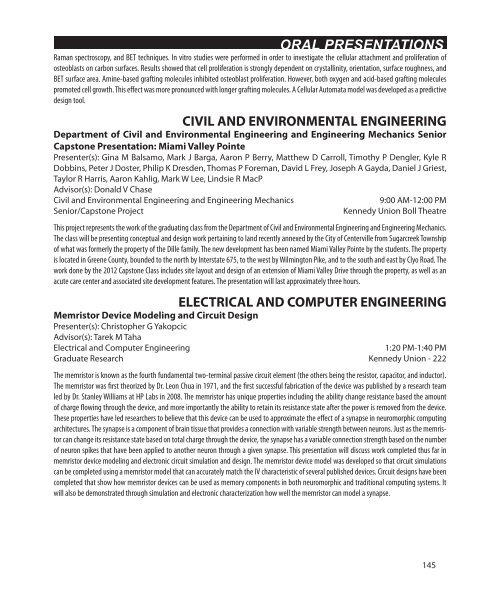Stander Symposium abstract book - University of Dayton
Stander Symposium abstract book - University of Dayton
Stander Symposium abstract book - University of Dayton
Create successful ePaper yourself
Turn your PDF publications into a flip-book with our unique Google optimized e-Paper software.
ORAL PRESENTATIONS<br />
Raman spectroscopy, and BET techniques. In vitro studies were performed in order to investigate the cellular attachment and proliferation <strong>of</strong><br />
osteoblasts on carbon surfaces. Results showed that cell proliferation is strongly dependent on crystallinity, orientation, surface roughness, and<br />
BET surface area. Amine-based grafting molecules inhibited osteoblast proliferation. However, both oxygen and acid-based grafting molecules<br />
promoted cell growth. This effect was more pronounced with longer grafting molecules. A Cellular Automata model was developed as a predictive<br />
design tool.<br />
CIVIL AND ENVIRONMENTAL ENGINEERING<br />
Department <strong>of</strong> Civil and Environmental Engineering and Engineering Mechanics Senior<br />
Capstone Presentation: Miami Valley Pointe<br />
Presenter(s): Gina M Balsamo, Mark J Barga, Aaron P Berry, Matthew D Carroll, Timothy P Dengler, Kyle R<br />
Dobbins, Peter J Doster, Philip K Dresden, Thomas P Foreman, David L Frey, Joseph A Gayda, Daniel J Griest,<br />
Taylor R Harris, Aaron Kahlig, Mark W Lee, Lindsie R MacP<br />
Advisor(s): Donald V Chase<br />
Civil and Environmental Engineering and Engineering Mechanics<br />
Senior/Capstone Project<br />
9:00 AM-12:00 PM<br />
Kennedy Union Boll Theatre<br />
This project represents the work <strong>of</strong> the graduating class from the Department <strong>of</strong> Civil and Environmental Engineering and Engineering Mechanics.<br />
The class will be presenting conceptual and design work pertaining to land recently annexed by the City <strong>of</strong> Centerville from Sugarcreek Township<br />
<strong>of</strong> what was formerly the property <strong>of</strong> the Dille family. The new development has been named Miami Valley Pointe by the students. The property<br />
is located in Greene County, bounded to the north by Interstate 675, to the west by Wilmington Pike, and to the south and east by Clyo Road. The<br />
work done by the 2012 Capstone Class includes site layout and design <strong>of</strong> an extension <strong>of</strong> Miami Valley Drive through the property, as well as an<br />
acute care center and associated site development features. The presentation will last approximately three hours.<br />
ELECTRICAL AND COMPUTER ENGINEERING<br />
Memristor Device Modeling and Circuit Design<br />
Presenter(s): Christopher G Yakopcic<br />
Advisor(s): Tarek M Taha<br />
Electrical and Computer Engineering<br />
1:20 PM-1:40 PM<br />
Graduate Research Kennedy Union - 222<br />
The memristor is known as the fourth fundamental two-terminal passive circuit element (the others being the resistor, capacitor, and inductor).<br />
The memristor was first theorized by Dr. Leon Chua in 1971, and the first successful fabrication <strong>of</strong> the device was published by a research team<br />
led by Dr. Stanley Williams at HP Labs in 2008. The memristor has unique properties including the ability change resistance based the amount<br />
<strong>of</strong> charge flowing through the device, and more importantly the ability to retain its resistance state after the power is removed from the device.<br />
These properties have led researchers to believe that this device can be used to approximate the effect <strong>of</strong> a synapse in neuromorphic computing<br />
architectures. The synapse is a component <strong>of</strong> brain tissue that provides a connection with variable strength between neurons. Just as the memristor<br />
can change its resistance state based on total charge through the device, the synapse has a variable connection strength based on the number<br />
<strong>of</strong> neuron spikes that have been applied to another neuron through a given synapse. This presentation will discuss work completed thus far in<br />
memristor device modeling and electronic circuit simulation and design. The memristor device model was developed so that circuit simulations<br />
can be completed using a memristor model that can accurately match the IV characteristic <strong>of</strong> several published devices. Circuit designs have been<br />
completed that show how memristor devices can be used as memory components in both neuromorphic and traditional computing systems. It<br />
will also be demonstrated through simulation and electronic characterization how well the memristor can model a synapse.<br />
145

















